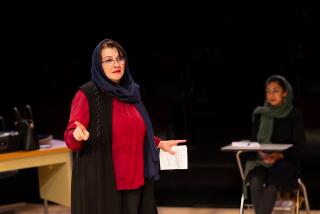Hundreds of languages are in danger of vanishing. A new audio project aims to preserve the sound of some of them
As the United Nations Educational, Scientific and Cultural Organization puts it, “language is one manifestation of cultural diversity” and “every language reflects a unique world-view with its own value systems, philosophy and particular cultural features.”
But the globe’s dynamic cacophony of spoken tongues is under threat. The U.N. agency forecasts that if nothing is done at least half of the 6,000 languages currently spoken will be extinct by the year 2100.
According to UNESCO, a language is endangered when its speakers stop using it, it is spoken “in fewer and fewer domains” and styles, or the language has stopped being passed on to the next generation. A language can also be considered endangered based on the proportion or percentage of speakers within the total population or the “availability of materials for language education and literacy,” according to the U.N. agency. Once a language is extinct, it means it is no longer the first tongue that infants learn at home and the language’s last speaker died within the last five decades, according to the agency.
The regions that are home to the most endangered languages include Melanesia, a Pacific island group northeast of Australia that includes Papua New Guinea, as well as sub-Saharan Africa and South America, but “endangered languages can be found in every region and in almost every country in the world,” the agency says.
Around 2,500 languages are in danger of becoming extinct, research shows, and some are spoken by as few as 30 people.
In an effort to save the sounds of these vanishing tongues, GoCompare, a British financial services website that provides comparison details for financial products, has launched a project to capture the tone and rhythm of some of them.
Known as a go-to site for flights, accommodation and travel insurance, GoCompare said the aim was to “highlight these beautiful languages and let the world hear how they sound.”
“When we lose a language, we don’t just lose words, we lose a whole perspective on the world,” Kathrine Stakston, a London-based spokeswoman for the project said in an email. “Often, it’s diversity and different perspectives which spark new initiatives, new ideas.”
The company found native speakers of 25 of the world’s endangered languages and asked each of them to record in their mother tongue the translation of legendary Italian filmmaker Federico Fellini’s phrase “a different language is a different vision of life.”
“We hope that this project will put the languages back on the map, tell their story and shed light on their importance,” Stakston said. “Hopefully, by initiating a conversation about diversity, different languages and cultures, we can start a bigger movement to preserve these languages and the culture they represent.”
Here’s a sampling of some of the disappearing languages the company recorded and some background it published.
Wiradjuri (Australia)
Wiradjuri is one of Australia’s 40 remaining indigenous languages, according to GoCompare. Only 30 people are known to speak it, primarily in the southwestern part of the state of New South Wales. A revival of the language is underway, helped by the publication of a dictionary and a growing number of schools incorporating the language into their curriculum, the company said.
Hear it here: Muriguwal dyiba dhuruwirradhi muriguwal ngaanyi murunhi.
Nawat (Latin America)
There are believed to be 200 speakers of this language, also known as Pipil, which is heard in El Salvador. It too could be experiencing a revival, as there are reportedly a growing number of second-language speakers of Nawat.
Hear it here: Kwak tikpiat ukse taketzalis, titachiat te kenha.
Ojibwe (North America)
Ojibwe is an indigenous language spoken by about 6,000 people in Michigan, Minnesota and Wisconsin. According to information published by the project’s researchers, the language consists of “a series of dialects bearing local names, and, quite frequently, local writing systems,” with no single dialect considered to be the standard version.
Hear it here: Bakaani-izhigiizhwewin bakaani-izhinamo bemaadizing.
Choctaw (North America)
About 9,500 people of the Choctaw Nation living mainly in Louisiana, Mississippi and Oklahoma speak the Choctaw language, according to the project. The official website of the Mississippi Band of Choctaw Indians notes that the language is “an essential element of the Tribal culture, tradition and identity.” The written language was developed in the early 19th century by Cyrus Byington, a Christian missionary from Massachusetts, according to the website.
Hear it here: Anompa inla ish anompolahinla hokmvt, okchanya inla ish pinsahinla.
North Frisian (Germany)
There are reportedly 10,000 speakers of this language, which is classified as being “severely endangered,” according to information published by researchers who recorded the endangered languages. North Frisian has “an extraordinary number of local dialects, some of which are mutually unintelligible,” according to the Encyclopedia Britannica, which reports that speakers of the language are typically bilingual or trilingual, with standard German being among their tongues.
North Frisian was reportedly recognized as the official language of North Germany’s Nordfriesland district and Heligoland in 2004.
Hear it here: En ouderen spräke as en ouderen wise, et laawen tu siien.
Balti (South Asia)
The number of people who speak Balti is unclear, but it is known to be spoken in northern Pakistan and some parts of northern India, according to project researchers. The language is said to incorporate “many words that are characteristic of Tibetan dialects.”
Hear it here: فروما چک سکت چی لوقسو لمتهونگ چک ان
Irish (Europe)
Also known as Gaelic, Irish was historically spoken by people from all strata of society until the time of the Great Famine in Ireland from 1845 to 1849, “when emigration led to a sharp decline in the population,” according to the website About World Languages.
Irish was adopted as an official language, along with English, when an independent Irish state was established in 1922, and it has since become a compulsory subject in government-funded schools, according to the website. Today, there are an estimated 440,000 people who speak Irish as a first language, the audio project’s researchers reported. It became an official language of the European Union in 2007, and its nearest relatives are Scottish Gaelic and Manx, the researchers said.
Hear it here: Tugann teanga eile amharc difriúil ar an saol.
For more on global development news, see our Global Development Watch page, and follow me @AMSimmons1 on Twitter
More to Read
Start your day right
Sign up for Essential California for news, features and recommendations from the L.A. Times and beyond in your inbox six days a week.
You may occasionally receive promotional content from the Los Angeles Times.







